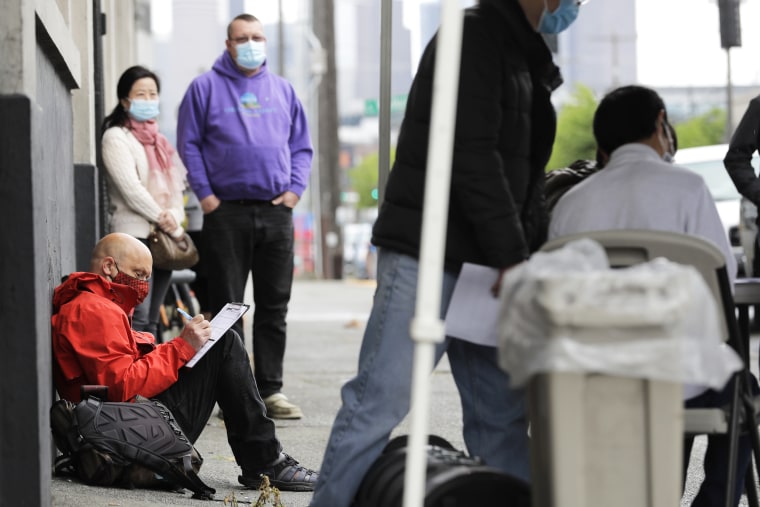The pandemic cleaved its way through the jobs market this year, carving a wide divide between the businesses that boomed during the crisis and those who were crushed by it.
Over 22 million jobs disappeared at the start of the pandemic. Only 12 million have been recovered, leaving another 10 million to go — and the pace of improvement has slowed to a crawl. So where did all the jobs go?
An NBC News analysis of data from the Bureau of Labor Statistics compared unemployment levels in November versus a year ago.
Industries positioned to benefit from the large number of Americans staying at home, working remotely and having foods and goods delivered in order to respect social distancing measures all saw gains. Courier, warehousing, building material and information services saw 3 to 18 percent increases in employment levels.
But nonessential sectors dependent on people showing up in-person, in groups, saw the biggest declines. Performing arts, spectator sports, transport, and retail clothing stores, and restaurants saw 19 to 62 percent drops.
Industry impacts
“Leisure and hospitality were the hardest hit because of the nature of the pandemic,” said Olugbenga Ajilore, senior economist at the liberal Center for American Progress think tank. ”People were not going out to eat and not traveling.”
With everyone sheltering in place, any business that couldn’t be done remotely was exposed to high levels of economic risk.
“All the low-wage and low-hours sectors were hit hardest in the early going,” as well as in passenger transportation, Daniel Alpert, managing partner at Westwood Capital, told NBC News in an email. “These sectors lost everything at first, regained some with the Paycheck Protection Program and warmer weather openings and consumer behavior, and in Q4 have been [losing] jobs all over again.”
Performing arts, museums, and child day care services have all been slammed with devastating job losses due to coronavirus-driven impacts. Even industries that might at first seem counterintuitive were hammered, like health care.
“Covid is really expensive. It absorbs all the resources. And the things that keep hospitals afloat, like elective surgeries, couldn’t happen,” Diane Swonk, chief economist at Grant Thornton, told NBC News. “And there’s collateral damage to doctors and physician offices… people were worried about going to the doctor and getting a contagion.”
Industries fade
The decline of some industries accelerated during the pandemic and could continue to fade or only continue in specialized forms. Coal mining continues to narrow in the face of cheap natural gas and increasingly efficient renewables, with two plants closing this month alone.
Family restaurants have also been increasingly closing.
Movie theaters will struggle to bring patrons back used to their streaming options, especially if the same movies are available on demand as well as in theaters.
“Theaters were struggling pre-pandemic. Now they might go the way of the drive-in,” Ajilore said. Cultural centers such as Los Angeles and New York City may end up as the only cities to offer a healthy number of such diversions, especially if the business can pivot to higher-margin experiential and dining aspects.
How well some of these industries do may depend on whether they can qualify for government assistance to carry them to the other side of the pandemic.
“When I think about the future… a lot depends on fiscal relief. Will it be a skinny bill or full relief?” Ajilore said. “As all provisions from the CARES act expire, that’s less money into economies. Without stimulus checks, people are not spending money.”
Industries adapt and grow
The tech sector is expected to keep growing as some behaviors learned during the pandemic — such as mass adoption of video conferencing and online delivery — will continue but then taper off slightly, said Michael Strain, director of economic policy studies at the American Enterprise Institute, a conservative economic think tank.
“Broadly, you'll see some sectors shrink and some grow over the first half [of 2021], and then see those sectors growing shrink a little, and those that shrunk a little, grow,” Strain said.
“People are doing a lot more of their shopping online and that requires delivery trucks and we’re going to see retail employment shrink,” Strain said. “Once we have vaccine ... distribution, we can expect to see some people switch some online shopping to in-person and then see recovery to some degree in retail, and then a reduction among delivery drivers.”
Some shifts in consumer and business behavior are likely to persist in a post-pandemic world, just like 9/11 caused permanent changes.
Living and working in the same city may no longer be the de facto norm. Employees may largely work remotely and only come in to an office on designated days for face-time and group brainstorming. Rural areas with natural environment gateways and broadband access may continue to boom as “Zoom towns,” bringing in new talent and an income tax base — while also driving up housing prices and straining local resources.
Just because this pandemic will eventually be behind us does not mean everything goes back to the way it was, experts say.
Federal Reserve Chair Jerome Powell has said one of the biggest risks to the economy is the "longer-run damage to the productive capacity of the economy and to people’s lives who have been disrupted by the pandemic.”
“We’re not going back to the same economy,” he said last month. “We’re recovering, but to a different economy and it will be one that is more leveraged to technology, and I worry that it’s going to make it even more difficult than it was for many workers.”
The pandemic will force the economy and society to make permanent changes to become ready and resilient for the next one, other experts agree.
“Covid-19 has been an accelerant that forced us to do things much faster — but that also means bigger disruptions,” Swonk said. “A pandemic is no longer a plot in a horror movie. It is now a risk that needs to be managed.”

